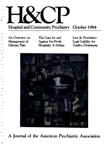Chronic Pain Management
Abstract
In the past ten years developments in social psychology, neurochemistry, learning theory, and psychophysiology have expanded the concept of chronic pain into a biopsychosocial model, in which pain is viewed as a form of abnormal illness behavior influenced by a wide range of biological, social, and psychological factors. Using the literature on chronic pain, the authors discuss the evolution of the chronic pain concept into the multidisciplinary multimodal approach used by pain clinics today, and the factors identified in the literature that influence a patient's perception of pain. Finally, based on their experiences in setting up a pain clinic and on the literature on leading pain management programs, they discuss in detail the evaluation, treatment, and management strategies of a comprehensive chronic pain management program.
Access content
To read the fulltext, please use one of the options below to sign in or purchase access.- Personal login
- Institutional Login
- Sign in via OpenAthens
- Register for access
-
Please login/register if you wish to pair your device and check access availability.
Not a subscriber?
PsychiatryOnline subscription options offer access to the DSM-5 library, books, journals, CME, and patient resources. This all-in-one virtual library provides psychiatrists and mental health professionals with key resources for diagnosis, treatment, research, and professional development.
Need more help? PsychiatryOnline Customer Service may be reached by emailing [email protected] or by calling 800-368-5777 (in the U.S.) or 703-907-7322 (outside the U.S.).



